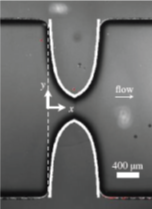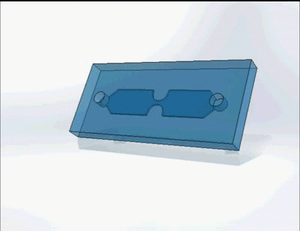Extensional viscosity is defined as the resistance of a fluid to flow through a field involving a change in cross-sectional area. In a previous blog post we shared the significant impact extensional deformation and shearing have on industrial processes, such as fiber spinning, paint rolling, roll coating, inkjet printing, spraying, electrospinning, enhanced oil recovery, drag reduction, and food processing. Understanding extensional viscosity allows you to understand your fluid composition, predict the impact of that composition on industrial processes, and optimize and improve your industrial processes.
Flow channel geometry can be varied to produce different types of continuous deformation. Changing the geometry of the microfluidic flow channel can introduce an extensional component to the deformation. Simple and complex fluids are both known to respond differently to steady shear versus extensional.

VROC® microfluidic flow channels are available with either a uniform cross-section for steady shear viscosity measurement or a centrally located hyperbolic contraction-expansion for extensional viscosity estimation. We are able to measure different solutions at several concentrations in both types of channels to illustrate the change in material response with deformation.
Different types of viscosity are defined based on the specific applied deformation and resulting stress response. The more commonly recognized steady shear viscosity (η) is defined by the ratio of the shear stress (σ) to the shear rate (γ ̇).

The continuous deformation known as shear rate is a velocity gradient perpendicular to the direction of flow and is achieved in the microfluidic flow channel with a uniform cross-section. The imposed gradient causes fluid elements to slide past each other. The extensional viscosity (ηE,a)) is defined as the ratio of the first normal stress difference (N1) to the extensional rate (εa).

The extensional rate is a velocity gradient in the same direction as the flow field and is accomplished in a channel with a centrally place hyperbolic contraction-expansion. It is the change in the cross-sectional area along the flow path that introduces the extensional type of deformation. Fluid elements are elongated or stretched upon entering the contraction..png?width=407&name=Extensional%20Viscosity%20(Blood).png)
Download our application note "Xanthan gum under steady shear & extension" to learn more about the ways different materials respond differently to the two types of deformation. In this application note, xanthan gum solutions were measured in uniform cross-section and hyperbolic contraction-expansion flow channels to demonstrate the different responses to steady shear versus extensional deformation.
Written by: Dr. Stacey Elliott, RheoSense Principal Scientist



